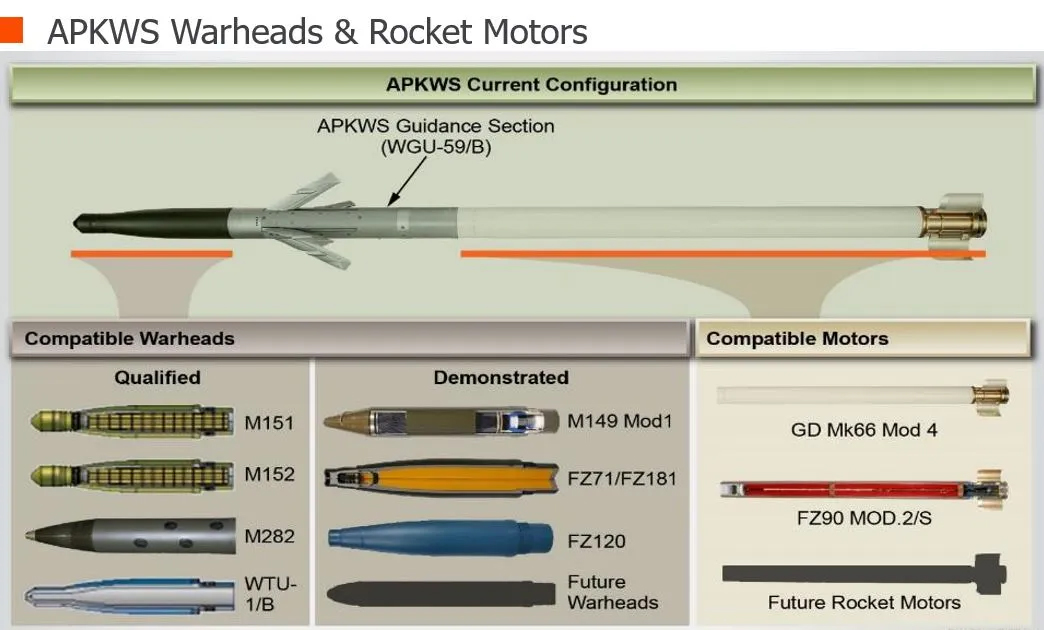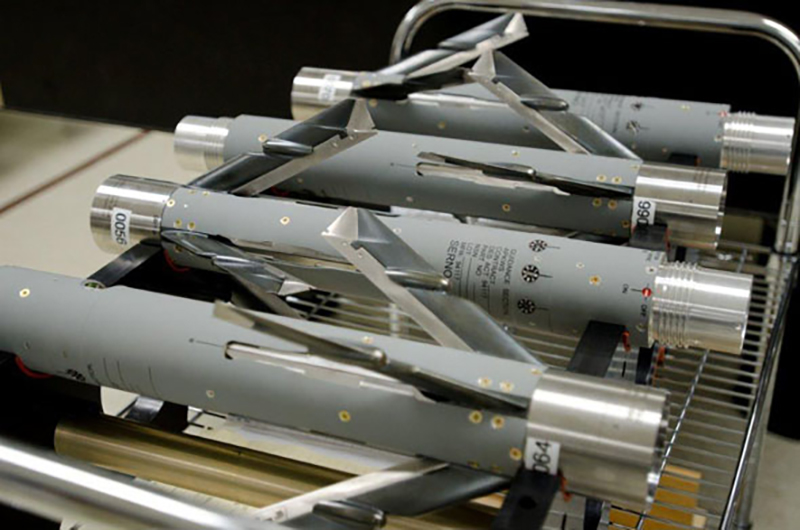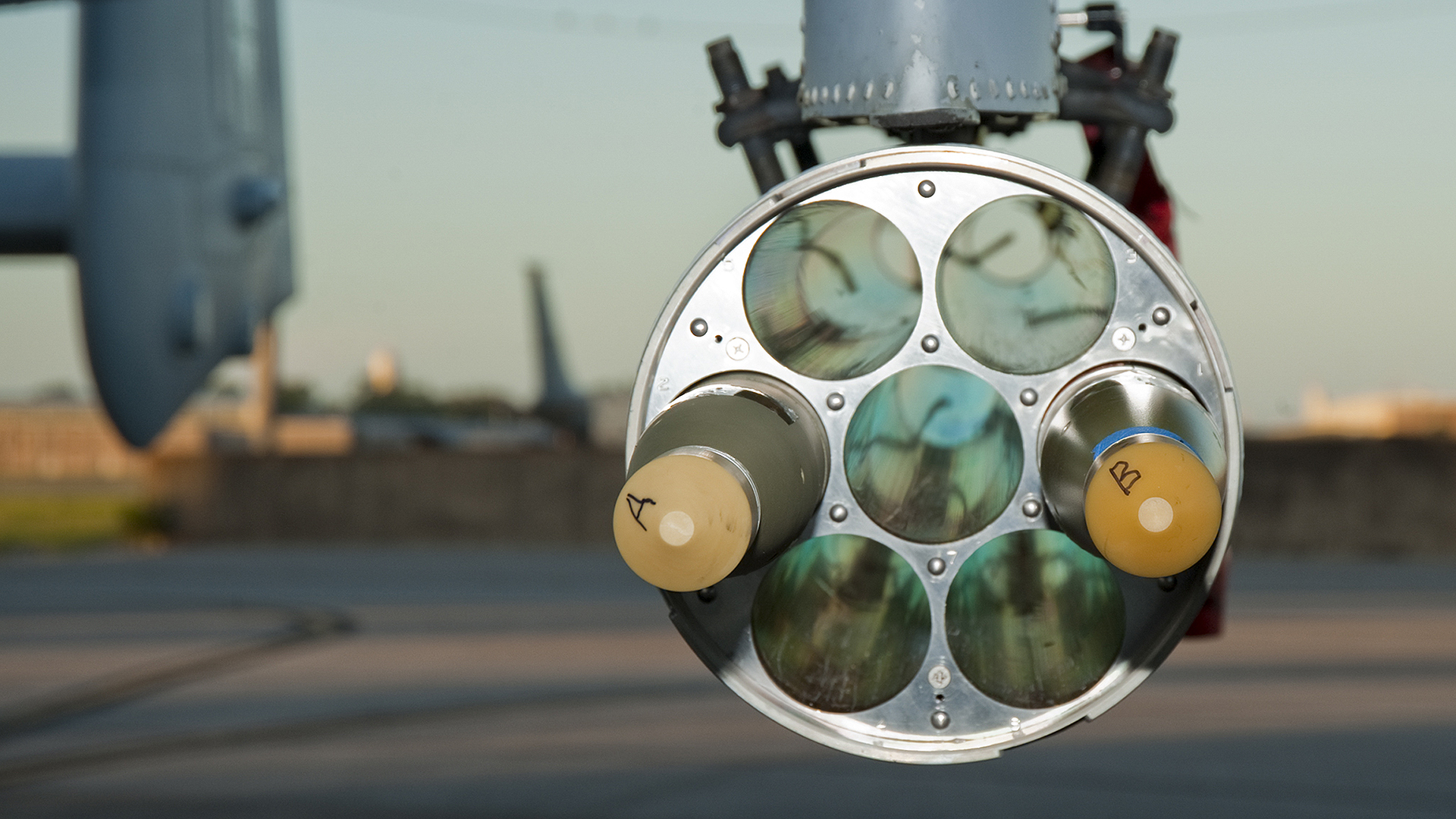Advanced Precision Kill Weapon System II, better known simply as APKWS, is slated to be demonstrated with a passive infrared seeker. The news came in the 2025 Marine Aviation Plan, which states that “Additional demonstrations are also in [the] work[s] with the Army and Air Force to determine [the] feasibility of adding additional guidance methods to the APKWS family, including passive infrared seekers.”
While little is known about this initiative, such a capability could potentially offer a far cheaper solution with independent targeting capabilities compared to existing missiles, while also increasing magazine depth on certain platforms dramatically.
BAE Systems’ APKWS takes 70mm Hydra unguided air-to-ground rockets with various warhead configurations and fits them with a small laser guidance section between the motor and the warhead. The employment concept is simple, put the laser on the target and fire the rocket within its engagement parameters and it will fly to that target with incredible precision and detonate. They can take out individuals in doorways and vehicles rushing across a roadway, for instance. They also do this at a fraction of the cost of traditional missiles, coming in at around $15,000 to $20,000 apiece for the guidance kit and a few grand more for the warhead and rocket motor. This is compared to hundreds of thousands of dollars, or more, for traditional missiles.


Since its introduction into service, APKWS has evolved in a snowballing manner. Now, as any sort of cost-per-shot ratio advantages are top of mind in the Pentagon, the precision-guided rockets are seen as a cheap way to take out targets on the ground and, increasingly, in the air, as well. This has led to APKWS’ adaptation into a surface-to-air effector, which has seen great success in Ukraine, and now as an air-to-air weapon in its own right.
Just last week, TWZ broke the news that USAF F-16s have been swatting down Houthi drones and cruise missiles with APKWS, which marked the operationalizing of a capability first demonstrated in 2019, but that has not been discussed publicly since. For an F-16, a seven-shot pod of the rockets more than doubles its air-to-air missile magazine depth while just occupying a single pylon.

Still, there are real limitations to APKWS in the anti-air role, whether fired from the ground or the air. It is generally usable against slower-flying drones and some cruise missiles, both of which are largely non-reactionary, non-hard-maneuvering targets. They also require the target to be lased (laser-designated) throughout the rocket’s flight. In other words, this is not a ‘fire-and-forget’ weapon, it needs to have its target illuminated until the warhead detonates. This limits the rapidity of multiple engagements and, especially for air-to-air applications, makes engagements tricky. For the latter, having one aircraft lasing and one firing would help with these limitations, especially considering that the rocket has limited range and speed, and the firing aircraft has to clear any blast fragmentation area quickly in order to not be struck by its own weapon’s effects.
What would make these engagements far easier is if the APKWS rocket was equipped with its own infrared seeker, something we have mentioned before. This would allow it to lock on before launch and fly to its target autonomously. This means multiple targets could be engaged far faster and, in many cases, in a safer manner. It also means that radar could be used to help initially acquire the target and point the seeker at it prior to firing, both in ground and air-based applications.
Think of it as firing a cheaper, shorter-range AIM-9 Sidewinder missile that has a use case not against other high-performance, hard-turning fighters, but for engaging drones and cruise missiles, which mainly fly in straight lines or maneuver at slower speeds and lower g-rates.
Costs could be cut by providing a simplified, staring imaging infrared seeker, potentially using commercially available off-the-shelf components. It would not need the range and counter-countermeasure capabilities of the AIM-9X, nor its high-off boresight capabilities.
It is also possible that an infrared seeker could be pursued for use in air-to-ground or surface-to-surface applications, as well. This would allow for targets to be engaged passively, without the use of a laser, which can be detected, and is another potential failure point and complication in the targeting process. It would also allow for vehicles to employ the rockets without a laser designator.

How exactly an imaging infrared seeker would be fitted into the APKWS is unclear as the small laser seekers are mounted on the forward fins that are part of the guidance section. Maybe small, very basic infrared sensors could be mounted similarly, but it’s more likely that putting single seeker in the traditional spot, on the nose, would be the solution, although it may increase expense and limit modularity.
In fact, a similar seeker system was already built and tested by the Navy a decade and a half ago. Low-Cost Imaging Terminal Seeker (LCITS) focused on engaging surface targets, especially swarming small boats. So it’s not like this hasn’t been done before and imaging infrared sensor technology has come a long way in the last 15 years.

LCITS ended up becoming something of a joint U.S.-South Korean program that continued development through to today under the Low-cost Guided Imaging Rocket (LOGIR) program primarily intended as a coastal defense system. You can read more about this here. The U.S. could adopt a version of the LOGIR system and even work to apply it in the counter-air role, or at least adapt technology it has gleaned from it to APKWS.

The bottom line here is that this could be a huge boost, especially in the anti-air role, for APKWS at a time when exactly this kind of cheaper, more plentiful solution is so badly needed to counter drones and lower-end cruise missiles. But even in the surface-to-surface and air-to-surface role alone it could be an exciting development.
We will let you know more about the initiative if we hear back from BAE Systems.
Contact the author: Tyler@twz.com
